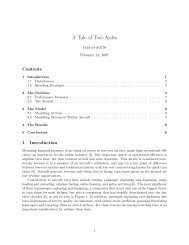Neural Models of Bayesian Belief Propagation Rajesh ... - Washington
Neural Models of Bayesian Belief Propagation Rajesh ... - Washington
Neural Models of Bayesian Belief Propagation Rajesh ... - Washington
You also want an ePaper? Increase the reach of your titles
YUMPU automatically turns print PDFs into web optimized ePapers that Google loves.
244 11 <strong>Neural</strong> <strong>Models</strong> <strong>of</strong> <strong>Bayesian</strong> <strong>Belief</strong> <strong>Propagation</strong> <strong>Rajesh</strong> P. N. Rao<br />
Inference in Spiking Networks<br />
By comparing the membrane potential equation (11.32) with the belief propagation<br />
equation in the log domain (equation (11.19)), we can postulate the<br />
following correspondences:<br />
vi(t + 1) = log m t i (11.34)<br />
f <br />
wijIj(t) = log P (I ′ |θ t i) (11.35)<br />
j<br />
g <br />
j<br />
Uijv ′ j(t) = log <br />
j<br />
P (θ t i|θ t−1<br />
j )m t−1,t<br />
j<br />
(11.36)<br />
The dendritic filtering functions f and g approximate the logarithm function,<br />
the synaptic currents Ij(t) and v ′ j (t) are approximated by the corresponding<br />
instantaneous firing rates, and the recurrent synaptic weights Uij encode the<br />
).<br />
transition probabilities P (θt i |θt−1 j<br />
Since the membrane potential vi(t+1) is assumed to be equal to log mt i (equation<br />
(11.34)), we can use equation (11.33) to calculate the probability <strong>of</strong> spiking<br />
for each neuron i as:<br />
(vi(t+1)−T )<br />
P (neuron i spikes at time t + 1) ∝ e<br />
∝ e<br />
(log mti<br />
−T )<br />
(11.37)<br />
(11.38)<br />
∝ m t i (11.39)<br />
Thus, the probability <strong>of</strong> spiking (or, equivalently, the instantaneous firing rate)<br />
for neuron i in the recurrent network is directly proportional to the message m t i ,<br />
which is the posterior probability <strong>of</strong> the neuron’s preferred state and current<br />
input given past inputs. Similarly, the instantaneous firing rates <strong>of</strong> the group <strong>of</strong><br />
neurons representing log m t,t+1<br />
i is proportional to m t,t+1<br />
i , which is the precisely<br />
the input required by equation (11.36).<br />
11.4 Results<br />
11.4.1 Example 1: Detecting Visual Motion<br />
We first illustrate the application <strong>of</strong> the linear firing rate-based model (section<br />
11.3.1) to the problem <strong>of</strong> detecting visual motion. A prominent property<br />
<strong>of</strong> visual cortical cells in areas such as V1 and MT is selectivity to the direction<br />
<strong>of</strong> visual motion. We show how the activity <strong>of</strong> such cells can be interpreted as<br />
representing the posterior probability <strong>of</strong> stimulus motion in a particular direction,<br />
given a series <strong>of</strong> input images. For simplicity, we focus on the case <strong>of</strong> 1D<br />
motion in an image consisting <strong>of</strong> X pixels with two possible motion directions:<br />
leftward (L) or rightward (R).<br />
Let the state θij represent a motion direction j ∈ {L, R} at spatial location<br />
i. Consider a network <strong>of</strong> N neurons, each representing a particular state<br />
θij (figure 11.4A). The feedforward weights are assumed to be Gaussians, i.e.<br />
F(θiR) = F(θiL) = F(θi) = Gaussian centered at location i with a standard
















